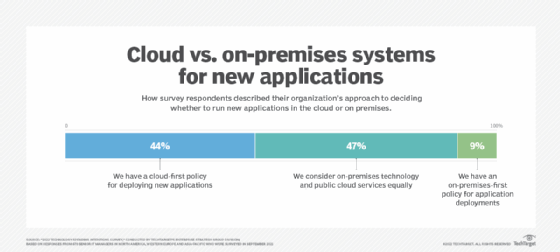
Getty Images/iStockphoto
Is a cloud-first strategy right for you?
A cloud-first strategy has its fair share of advantages and disadvantages. Learn how to avoid risks and build a strategy that is right for your organization.
The majority of new application development targets public cloud hosting. What's now called cloud-first is already an accepted strategy. It's important to look beyond that to the productivity gains that are driving both cloud and the data center.
While a cloud-first strategy has its benefits, it also has drawbacks. Build your strategy knowing how to best create a cloud-first culture.
What is a cloud-first strategy?
Over the last decade, enterprises have recognized that data is only one aspect of application success. This transformation is driving a cloud-first strategy and has split the concept into two competing definitions.
Migrate to the cloud. This cloud-first strategy definition means moving all or most of computing infrastructure to public cloud. Almost every enterprise uses the cloud as a means of tuning information delivery to improve its value. However, very few consider moving everything to the cloud. Other than a change in pricing that would make cloud computing far cheaper than the data center, it's hard to see what could justify changing the appeal of the hybrid cloud model.
Prioritize cloud. Prioritizing cloud is when an enterprise looks first to cloud offerings when it considers a new project or seeks to fix a problem. A new project or problem would, in most cases, involve data already collected, since the most useful information to a company is derived from its normal operation. This qualification means that companies should consider hybrid-cloud applications for all new projects or problems.

Should you adopt a cloud-first strategy?
The benefit of this model of cloud-first thinking is that it directly ties application planning to the business goal of empowerment. However, there are risks.
Before moving ahead with a cloud-first strategy, assess current -- as well a future --applications. Keep these risks in mind before moving forward.
Vendor lock-in
Most applications are adapted to a particular cloud. Services like IaaS are generic, but most applications use web services APIs to speed development and link to services like database access. Applications written to those APIs aren't portable to other clouds without modification. A more portable option is to use a cloud platform from a vendor such as IBM, Red Hat or VMware and run it on an IaaS or simple container service in the cloud. These will run on nearly all public clouds.
Security and compliance
Security and compliance problems are more difficult to resolve. Most often, these problems result from data stored in the cloud. The second definition of cloud-first, which doesn't migrate applications from data center to cloud, is less likely to create security and compliance problems. If a true hybrid cloud relationship exists with the data center, most data will remain in the data center and new problems will be confined to the APIs. Traditional API security measures and VPN access control can manage security and compliance concerns there.
Cost
Cost overrun issues are the most difficult cloud-related risks to resolve. As valuable as scalability is, it also means that the cost of cloud computing will vary. Sometimes, the cost will drive an enterprise to move the application back to the data center. Assess traffic, traffic variability and cost of cloud services to ensure costs stay within your goal.
First-time cloud users are often unprepared for the difference in both development and operations skills and tools required. If used, specific application features and cloud services can add to costs. A pilot test is essential to ensure that these cost overruns don't harm your project.







